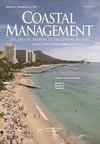交互式可视化在发展利益相关者对自然资源决策理解中的作用:以新西兰坎特伯雷的怀霍拉/埃尔斯米尔湖为例
IF 1.9
4区 环境科学与生态学
Q4 ENVIRONMENTAL SCIENCES
引用次数: 2
摘要
摘要本研究旨在探讨环境变化可视化呈现形式是否会影响利益相关者对自然资源决策的理解,并以新西兰的怀霍拉湖/埃尔斯米尔湖为例进行研究。由(Otinpong 2013)开发的交互式可视化(I-Vis)工具“ElleVis”显示了不同水位对生活在湖中和周围的动植物的影响。采用了一种实验设计,其中40名利益相关者被随机分配到使用I-Vis或非交互式可视化纸质形式(NI-Vis)展示这些信息。虽然两组利益相关者对信息的理解都有显著提高,但使用I-Vis呈现信息的利益相关者比使用NI-Vis呈现信息的利益相关者在理解方面取得了统计学上显著的进步(t(38)=2.663, p< 0.05)。与参与者进行的半结构化讨论证实了利益相关者对可视化交互性的重视。研究结果为讨论I-Vis工具如何有助于理解有争议的资源和/或涉及多种利益的环境管理情况提供了信息。本文章由计算机程序翻译,如有差异,请以英文原文为准。
The Role of Interactive Visualization in Developing Stakeholders’ Understanding of Natural Resource Decision-Making: A Case Study of Te Waihora/Lake Ellesmere, Canterbury, New Zealand
Abstract The purpose of this study was to investigate whether stakeholders’ understanding of natural resource decision-making was influenced by the form that visualization of environmental changes were presented, using Te Waihora/Lake Ellesmere, New Zealand as a case study. An interactive visualization (I-Vis) tool “ElleVis,” developed by (Otinpong 2013), shows the effects of different water levels on the flora and fauna living in and around the lake. An experimental design was used in which 40 stakeholders were randomly assigned to a presentation of this information using I-Vis or a non-interactive paper form of the visualization (NI-Vis). While stakeholders in both groups significantly improved their understanding of information, stakeholders presented with information using I-Vis made a statistically significant greater gain in understanding than those presented information using NI-Vis (t(38)=2.663, p<.05). Semi-structured discussions with participants confirmed the importance stakeholders placed on the interactive nature of the visualizations. The findings inform discussions about how I-Vis tools might contribute to an understanding of environmental management situations where contested resources and/or a multiplicity of interests are involved.
求助全文
通过发布文献求助,成功后即可免费获取论文全文。
去求助
来源期刊

Coastal Management
环境科学-环境科学
CiteScore
6.00
自引率
0.00%
发文量
24
审稿时长
>36 weeks
期刊介绍:
Coastal Management is an international peer-reviewed, applied research journal dedicated to exploring the technical, applied ecological, legal, political, social, and policy issues relating to the use of coastal and ocean resources and environments on a global scale. The journal presents timely information on management tools and techniques as well as recent findings from research and analysis that bear directly on management and policy. Findings must be grounded in the current peer reviewed literature and relevant studies. Articles must contain a clear and relevant management component. Preference is given to studies of interest to an international readership, but case studies are accepted if conclusions are derived from acceptable evaluative methods, reference to comparable cases, and related to peer reviewed studies.
 求助内容:
求助内容: 应助结果提醒方式:
应助结果提醒方式:


